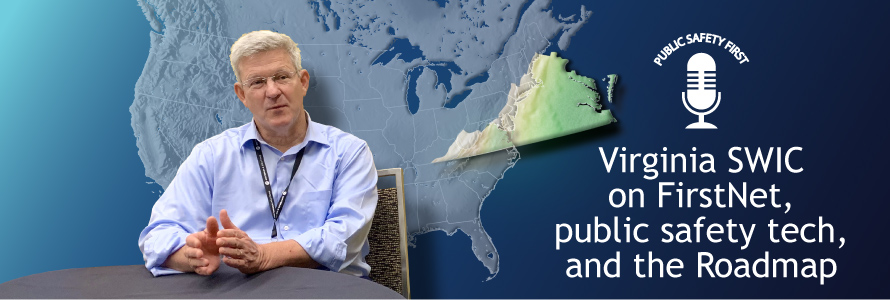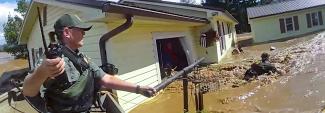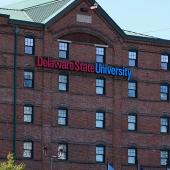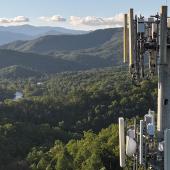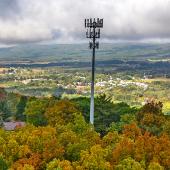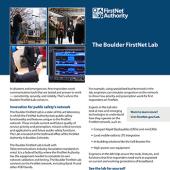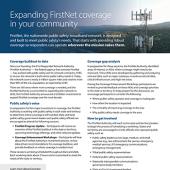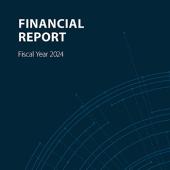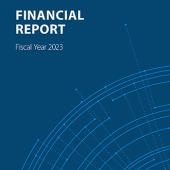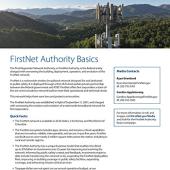Summary
FirstNet Authority Senior Public Safety Advisor Lori Stone sits down with the Commonwealth of Virginia’s Statewide Interoperability Coordinator Tom Crabbs to discuss FirstNet, how first responders are exploring and adapting cutting-edge technologies, and how the FirstNet Authority is helping public safety agencies nationwide advance operations.
Guest
Lori Stone
FirstNet Authority Senior Public Safety Advisor
Tom Crabbs
Virginia Statewide Interoperability Coordinator
Transcript
Preview
Narrator: You're listening to Public Safety First, a podcast to help you learn about the First Responder Network Authority and how you can be part of the future of public safety technology.
Lori Stone: Hello, I am Lori Stone, I am the Senior Public Safety Advisor for the Mid-Atlantic Region for the First Responder Network Authority, and I’m here talking today with Tom Crabbs, who is the Statewide Interoperability Coordinator [SWIC] for the Commonwealth of Virginia. We’re going to be talking about FirstNet in Virginia, and looking forward to some of the Roadmap activities that we’re going to be doing with Virginia.
So Tom, thanks for joining me. Pleased to have you –
Tom Crabbs: Good morning, Lori. It’s great to be here.
Lori Stone: – join us.
Tom Crabbs: Thanks so much for having me.
Narrator: You're listening to Public Safety First, a podcast to help you learn about the First Responder Network Authority and how you can be part of the future of public safety technology.
Lori Stone: Hello, I am Lori Stone, I am the Senior Public Safety Advisor for the Mid-Atlantic Region for the First Responder Network Authority, and I’m here talking today with Tom Crabbs, who is the Statewide Interoperability Coordinator [SWIC] for the Commonwealth of Virginia. We’re going to be talking about FirstNet in Virginia, and looking forward to some of the Roadmap activities that we’re going to be doing with Virginia.
So Tom, thanks for joining me. Pleased to have you –
Tom Crabbs: Good morning, Lori. It’s great to be here.
Lori Stone: – join us.
Tom Crabbs: Thanks so much for having me.
Lori Stone: You’ve been about a year and a couple months on the job as the SWIC of Virginia. Can you tell me, you know, what you’ve learned in that time, and how do you see the job evolving?
Tom Crabbs: I wish I could tell you precisely what I’ve learned. As technology’s changed, as people change, as practices change, standard operating procedures are changing. I think that we’re at an acceleration point, and I think we’re going to continue to accelerate, but I don’t know how much different it’s been from the past. Technologies and peoples’ use of technology has always changed, and it’s always an evolving arena. I think maybe just a little bit, evolving a little bit faster now, than it has in the past.
Lori Stone: Virginia’s a big state, and you hear probably a cross-section of opinions and thoughts about FirstNet. Can you share anything about what people in Virginia are using or thinking about FirstNet?
Tom Crabbs: Certainly. I like to say about Virginia – if you’ve visited one locality, you’ve visited one locality. Each one has its specific characteristics and approach to what they do. We are a commonwealth. I think everyone is interested and excited in leveraging public safety broadband, and FirstNet has brought a great new frontier, and it is front and center on everybody’s look towards the future. As our localities plan towards the future, certainly their consideration for the technologies that FirstNet brings is something they’re factoring into their own strategies. Indeed, we’re updating our state strategy now, and the inclusion of public safety broadband is one of our four pillars of considerations – those four pillars being land-mobile radio [LMR], public safety broadband, alerts and warnings, and 9-1-1, and of course we’re advancing into Next Generation 9-1-1 in the state of Virginia.
Lori Stone: So, the four pillars are really the foundation for communications, public safety, interoperability in Virginia, you would say – that’s your theme and how you’re working it?
Tom Crabbs: Yes, absolutely. Well said. And, there is an umbrella now that covers those four pillars, and that is considerations for cybersecurity, which impact each of those pillars as we move forward.
There’s a lot of discussion about LMR and public safety broadband and if one is going to replace the other, and when you look at those four pillars, and again, cyber being an umbrella over the top of all four pillars, that’s a system. That’s a system that works together. Each complements the others, and each has its own role. What I think we’ll see as the future unfolds is an evolution of how each of those technologies augments the other. And with the increasing presence of public safety broadband and what we can do with that to increased shared understanding, minimized delay, and maximizing effect, those who are using it will change it. It will be the behavior of use that determines the prevalence of one technology relative to another within that ecosystem. And there’s a lot of talk about mission-critical push-to-talk. We need to approach these technologies as an ecosystem working together, and then move through them, and we will see, as we continue to employ the technologies, those who use them will know how best to employ them. And they know that through risk assessment.
All incidents, events, and disasters begin and end locally, and you can continue to press that down to the individual responder or the individual planner. They’re the ones who know what they trust, because they’re the ones who ultimately bear the risk of any of these circumstances. So, to frame it as LMR versus broadband is kind of a distracting discussion. We need to continue, as you are through the Roadmap, to bring what’s available, to present what’s available, to the users – today’s and future users – so that they can determine what they trust relative to their risk and make the right choices.
Lori Stone: You mentioned looking at the future and future technologies. I know we talk often about who in the Commonwealth of Virginia is able to think about FirstNet five years from now, but we also talk about just using FirstNet in the future, that’s what our Roadmap is predicated upon. As you know, we’ve talked a lot about where technology is going. Where do you see some of those technologies that you’ve been talking to people about in your travels?
Tom Crabbs: To communicate is a word that we use to cover a broad concept, and I think that our public safety communicators and first responders and all-hazard responders understand that communication is shared understanding. It’s not about hearability, it’s not about transmission and receipt. Do I understand what the person who is communicating with me is trying to share, and do we have a shared understanding? Shared understanding enables what we’re really after with public safety, and that is minimized delay and maximized effect. So as our localities approach the technologies that FirstNet brings, they’re really developing requirements that are going to enable them to minimize delay and maximize effect of their response and their planning. The FirstNet technologies allow us to overlay communications plans that are more sophisticated into planned events. As we set up our ICS [Incident Command System] structures, the communications leader is able to work to provide FirstNet capabilities that better allow shared understanding throughout that integrated command structure that enables better responses, should they be necessary.
Lori Stone: That’s a whole ecosystem you’re talking about from, you know, 9-1-1 call to, you know, the response, to the recovery –
Tom Crabbs: It is the ecosystem.
Lori Stone: – through that, yeah.
Tom Crabbs: And it’s easy to talk about the ecosystem here, and it makes a lot of sense, but when I need to share understanding, or somebody needs to share understanding with me, it’s just a small slice of that ecosystem. So, as the technologies evolve, the more those who are using them see the benefits that allow shorter delay and response, and better effect of the response, it builds trust with them. Once you understand that it’s good, and it provides you an advantage, you don’t normally look back. You want more of it. And I expect that to happen.
The way that in Virginia that we approach our relationships between the state and the localities – if you could envision an inverted pyramid with the state at the bottom supporting the localities at the top.
And one of the things that we’re always concerned about at the state level as we approach new initiatives is to ensure that they are informed by the localities. And you’re always looking out for the bear trap that is this unfunded mandates. “I have a great idea from Richmond that you should introduce and employ, and it’s going to cost you this much.” That’s not something that the localities need. Localities struggle with operability every day. If I bring them interoperability solutions that are going to cost them money, they’re not going to be popular and they’re probably not going to be used. So, Virginia’s approach is to work with the localities, and our governance structure is set up to enable that.
We have seven regions in Virginia, and we call those RPACs – that’s Regional Preparedness Advisory Committee – and then dash “I” for Interoperability, and we have one for each region, and the RPAC aim is to reach to individual localities and stakeholders and ensure that their voices are heard to advise – again, Preparedness Advisory Committee – advise the state on what is best for the localities. So somewhere in between stakeholder desires and the state’s aim in meeting those desires are the realities of technology and the cost of that technology. So, Virginia approaches our technological solutions and governance solutions for interoperability by engaging the localities and their stakeholders to ensure that we’re meeting their requirements.
Lori Stone: I think that you summed it up perfectly at the end there.
Tom Crabbs: Okay, good.
Lori Stone: That is, I think, the approach every state should be taking. You know, listening to the locals. All emergencies are local, they start and they end there, and then the state and feds come in sometimes to help and support, but if it’s not used well on the local level, then I think we’ve failed in our overall mission of bringing public safety broadband to public safety. So the FirstNet Authority is very appreciative of everything the Commonwealth of Virginia has done in terms of opting in first, of leading the way, of having a strong governance body, and I always cite Virginia as a model that other states should look for from leading, really, from the ground up. So you said it very well.
Tom, I want to move to another subject. You were one of the attendees at one of the very first Roadmap workshops that was held in the country – that was back in April in Fairfax County – and it was participants from Northern Virginia, the District of Columbia, and Maryland. We had about 50, 60 people in the room talking about mission-critical video and mission-critical data. Could you share some of your observations and what you took away from that session?
Tom Crabbs: Yes, I can. So, I was there with a colleague from Virginia Department of Emergency Management [VDEM], Mike Keefe, who directs communications for VDEM. Very well experienced and trusted communications specialist in Virginia, and somebody I rely on very closely. And when we were finishing, I turned to Mike and I said, “This makes LMR look simple.” It was an excellent exercise or workshop. We want to be able to see from the 40,000-foot level all of the possibilities that these new technologies are bringing, and we have to keep in mind from that 40,000-foot level that that’s going to continue to expand. We don’t see everything today that will be tomorrow. You captured what we see today, so you brought us from that 40,000-foot level to about 20,000 feet. And then you chose various disciplines within the FirstNet offerings, and you made us walk through those. And you used Poll Everywhere to ask questions and then get our feedback immediately, and that’s excellent.
And you used that again with our State Interoperability Executive Committee as we walked through a few other issues like this, and that immediate feedback that spurs more thought and more communication is excellent. By giving us the opportunity to, sort of, look at what the whole is out there, and then breaking it down, and then allowing us to give you feedback with well-crafted questions – you’re basically giving us the opportunity to develop the requirements of the near and far future, and that’s really what’s important.
I mentioned that earlier – communication is shared understanding. We need to look towards solutions that minimize delay and maximize effect. That leads us to the hard stuff. At the 30,000-foot level, you just want to look at that on a big, white piece of paper and say, “What are our requirements? Where do we want to go with this?” I think you’re doing that at FirstNet for us. You’re, because as you discussed earlier, you mentioned, everyone here has got a day job. A very important day job. They’re saving lives, they’re protecting lives every day, so, when you come out with a workshop that allows us to take a morning, or maybe a day to think on that big white canvas that you’ve sort of narrowed down a little bit about the requirements of what the future are, and make us critically think with some well-crafted questions, you’re doing us a great favor. And I’m ever grateful for that, and I appreciate you continuing to make those opportunities available with more workshops. They’re invaluable, not just for today, but I think for your intent, the near future, and we should be looking to the far future for that, too. So thank you very much for making those possible, and we’re going to take great advantage of them in Virginia, because it does, it gives us a moment to think about those requirements. If we had more time, we’d spend a lot of time thinking about requirements. You’ve given us the opportunity to dedicate and drill down on it.
Lori Stone: Well –
Tom Crabbs: Thank you very much.
Lori Stone: – thank you. It wouldn’t be without your participation and your enthusiasm, and the fact that you fully support what we’re doing.
Tom Crabbs: Thanks. You’ve got the state’s backing on these workshops and the like to help us move towards those requirements. It’s healthiest when the users drive the requirements, vice the industry driving the requirements. And it’s all well-intended. Everybody’s doing their best to provide the best, and you’re providing us a great avenue for a voice opportunity to those who will provide what we need, and it’s welcomed, and again, we’re grateful for it. Thanks, Lori.
Lori Stone: Tom Crabbs, SWIC of Virginia, and also SPOC [State Point of Contact], as well, with FirstNet. Thank you so much for taking your time to talk with us today. I’m Lori Stone with the First Responder Network Authority, and we appreciate you listening. Thank you.
Narrator: Thanks for listening today. We're excited to have you join our podcast community. Make sure to subscribe on iTunes, SoundCloud, and YouTube. You can learn more about the First Responder Network Authority at FirstNet.gov and learn about FirstNet products and services at FirstNet.com.


